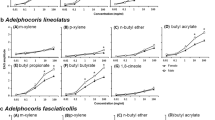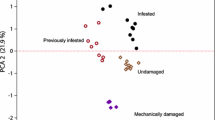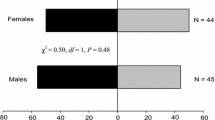Abstract
Volatiles from wheat and oat seedlings elicited attraction in apterae and alatae Rhopalosiphum padi. Cereal volatiles were identified by GC-MS and olfactometric tests were performed with each compound. Attraction of aphids was elicited by (E)-2-hexenyl acetate, (Z)-3-hexenol, (E)-2-hexenyl acetate, (E)-2-hexenol, (Z)-2-hexenol, n-heptanal, n-octanal, n-nonanal, n-decanal, benzaldehyde, and linalool. The difference between the sensory capacity of alatae and apterae is discussed in relation to migrations between hosts during their life cycle.
Similar content being viewed by others
REFERENCES
Alikhan, M. A. 1960. The experimental study of the chemotactic basis of host-specificity in a phytophagous insect, Aphis fabae Scop. (Aphididae: Homoptera). Ann. Univ. Maria Curie-Sklodowska Lublin Sect C 15:117–157.
Blight, M. 1990. Techniques for isolation and characterisation of volatile semiochemicals of phytophagous insects, pp. 281–288, in A. R. McCaffery, and I. D. Wilson (eds.). Chromatography and Isolation of Insect Hormones and Pheromones. Plenum Press, New York.
Buttery, R. G., Ling, L. C., and Wellso, S. G. 1982. Oat leaf volatiles: Possible insect attractants. J. Agric. Food Chem. 30:791–792.
Buttery, R. G., Xu, C.-J., and Ling, L. C. 1985. Volatile components of wheat leaves (and stems): Possible insect attractant. J. Agric. Food Chem. 33:115–117.
Hamilton-Kemp, T. R., and Andersen, R. A. 1984. Volatile compounds from Triticum aestivum. Phytochemistry 23:1176–1177.
Hatanaka, A. 1993. The biogeneration of green odour by green leaves. Phytochemistry 34:1201–1218.
Manahan, S. E. 1994. Environmental Chemistry, 6th ed. Lewis Publishers, Chelsea, Michigan, pp. 353–379.
Niemeyer, H. M. 1990. The role of secondary plant compounds in aphid-host interactions, pp. 187–205, in R. K. Campbell and R. D. Eikenbary (eds.). Aphid-Plant Genotype Interactions. Elsevier, Amsterdam.
Nottingham, S. F., Hardie, J., Dawson, G. W., Hick, A. J., Pickett, J. A., Wadhams, L. J., and Woodcock, C. M. 1991. Behavioural and electrophysiological responses to aphids to host and non-host plant volatiles. J. Chem. Ecol. 17:1231–1241.
Pettersson, J. 1970. Studies on Rhopalosiphum padi (L.) I. Laboratory studies of olfactometric responses to the winter host Prunus padus (L.). Lantbrukshogskolan Ann. 36:381–399.
Pettersson, J. 1973. Olfactory reactions of Brevicoryne brassicae (L.) (Hom.: Aph.). Swed. J. Agric. Res. 3:95–103.
Pettersson, J. 1993. Odour stimuli affecting autumn migration of Rhopalosiphum padi (L.) (Hemiptera: Homoptera). Ann. Appl. Biol. 122:417–425.
Pettersson, J., Pickett, J. A., Pye, B. J., Quiroz, A., Smart, L. E., Wadhams, L. J., and Woodcock, C. M. 1994. Winter host component reduces colonization by bird-cherry-oat aphid, Rhopalosiphum padi (L.) (Homoptera, Aphididae), and other aphids in cereal fields. J. Chem. Ecol. 20:2565–2574.
Pospisil, J. 1972. Olfactory orientation of certain polyphagous insects in Cuba. Acta Entomol. Bohemoslov. 69:7–17.
Quiroz, A., Pettersson, J., Pickett, J. A., Wadhams, L. J., and Niemeyer, H. M. 1997. Semiochemicals mediating spacing behavior of the bird-cherry-oat aphid, Rhopalosiphum padi feeding on cereals. J. Chem. Ecol. 23:2599–2607.
Schwimmer, S. 1981. Source Book of Food Enzymology. Avi Publishing, Westport, Connecticut.
Tjallingii, W. F. 1995. Aphid-plant interaction: What goes on in the depth of the tissue? Proc. Exp. Appl. Entomol. 6:163–169.
van Giessen, W. A., Fescemyer, H. W., Burrows, P. M., Peterson, J. K., and Barnett, O. W. 1994. Quantification of electroantennogram responses of the primary rhinaria of Acyrtosiphum pisum (Harris) to C4–C8 primary alcohols and aldehydes. J. Chem. Ecol. 20:909–927.
Visser, J. H., and Taanman, J. W. 1987. Odour-conditioned anemotaxis of apterous aphids (Cryptomyzus korschelti) in response to host plants. Physiol. Entomol. 12:473–479.
Wiktelius, S. 1989. Migration of apterous Rhopalosiphum padi. WPRS Bull. 12:1–6.
Yan, F.-S. and Visser, J. H. 1982. Electroantennogram responses of the cereal aphid Sitobion avenae to plant volatile components. Proceedings 5th International Symposium on Insect-Plant Relationships. Pudoc, Wageningen, pp. 387–388.
Zadoks, J. C., Chang, T. T., and Konsak, C. F. 1974. A decimal code for the growth stages of cereals. Weed Res. 14:15–21.
Author information
Authors and Affiliations
Rights and permissions
About this article
Cite this article
Quiroz, A., Niemeyer, H.M. Olfactometer-Assessed Responses of Aphid Rhopalosiphum padi to Wheat and Oat Volatiles. J Chem Ecol 24, 113–124 (1998). https://doi.org/10.1023/A:1022393029987
Issue Date:
DOI: https://doi.org/10.1023/A:1022393029987




